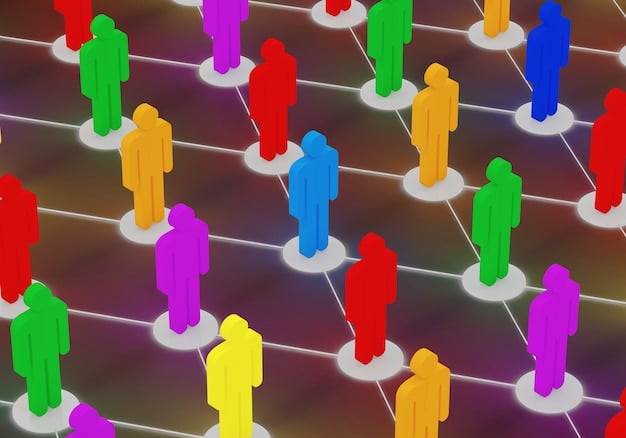Understanding the Impact of the 2025 COLA on US Federal Benefits

The Impact of the 2025 Cost-of-Living Adjustment (COLA) on Federal Benefit Programs is significant, as it ensures that benefits keep pace with inflation, helping to maintain the purchasing power of millions of Americans who rely on these crucial programs.
Understanding the implications of adjustments to federal benefit programs is essential for recipients and taxpayers alike. Let’s delve into the impact of the 2025 Cost-of-Living Adjustment on Federal Benefit Programs.
What is the Cost-of-Living Adjustment (COLA)?
The Cost-of-Living Adjustment, or COLA, is a mechanism designed to protect the purchasing power of federal benefits by ensuring that they keep pace with inflation. Understanding how COLA works is crucial to appreciating its impact on various programs.
It’s not just about adding more dollars; it’s about maintaining the real value of the benefits that people depend on.
How COLA is Calculated
The Social Security Administration (SSA) uses the Consumer Price Index for Urban Wage Earners and Clerical Workers (CPI-W) to calculate COLA. This index measures changes in the price of goods and services over time.
The COLA is typically announced in October each year and takes effect in January of the following year.
- CPI-W tracks the cost of living.
- SSA uses CPI-W to determine COLA.
- COLA is announced in October.
- Adjustments take effect in January.

Without COLA, inflation would erode the value of benefits, leaving recipients with less purchasing power. COLA helps ensure that beneficiaries can afford essential goods and services.
Social Security Benefits and the 2025 COLA
Social Security is one of the largest federal benefit programs in the United States, providing retirement, disability, and survivor benefits to millions of Americans. The annual COLA significantly affects the amount of these benefits.
Let’s examine how the 2025 COLA will play out for Social Security recipients.
Expected Changes to Social Security Payments
The 2025 COLA will lead to an increase in monthly Social Security payments. The exact percentage will depend on the CPI-W data from the preceding year, but recipients can expect a boost in their income.
These changes influence individual beneficiaries and the overall economy, as increased spending can stimulate economic growth.
- Increased monthly payments.
- Ensured purchasing power.
- Positive impact on the economy.
Social Security benefits are a lifeline for many retirees and disabled individuals. The COLA ensures that these benefits remain adequate to meet their needs.
Impact on Supplemental Security Income (SSI)
Supplemental Security Income (SSI) is another crucial federal benefit program that provides financial assistance to aged, blind, and disabled individuals with limited income and resources. COLA also affects SSI payments.
Understanding how COLA affects SSI is essential for those who rely on it for their basic needs.
SSI and Inflation Protection
Like Social Security, SSI benefits are adjusted annually to reflect changes in the cost of living. This adjustment helps ensure that SSI recipients can afford essential items such as food, housing, and medical care.
Without COLA, SSI recipients would struggle to maintain their standard of living in an inflationary environment.
The COLA provides a safety net, helping the most vulnerable members of society.
The COLA adjustment helps to maintain the real value which is critical for those with limited resources.

Veterans Affairs (VA) Benefits and COLA
Veterans Affairs (VA) benefits provide compensation, pensions, and other forms of assistance to veterans and their families. These benefits are also subject to COLA adjustments, ensuring that veterans can maintain their quality of life.
The benefits from VA are vital for the well-being of those who have served and sacrificed for the country. Here’s how COLA plays its part.
Supporting Veterans Through COLA
The VA uses COLA to adjust disability compensation, pension payments, and other benefits. This adjustment helps veterans cope with rising costs and ensures they receive the support they deserve.
Stable and reliable, these adjustments allow veterans to plan for their financial futures with greater confidence.
- Adjustments to disability compensation.
- Pension payments keep pace with inflation.
- Support for veterans and their families.
VA benefits are intended to recognize and support the sacrifices made by veterans. The COLA helps ensure that these benefits remain meaningful over time.
Federal Retirement Programs and the 2025 COLA
Federal retirement programs, such as those for civil service employees and military retirees, also receive COLA adjustments. These adjustments help ensure that retirees can maintain their standard of living throughout their retirement years.
Let’s consider how these programs are affected by the 2025 COLA.
Securing Retirement Income
COLA adjustments to federal retirement programs provide retirees with a stable and predictable income stream. This allows them to cover essential expenses and enjoy their retirement without financial hardship.
It’s a crucial aspect of retirement planning and financial security for federal employees and military personnel.
Without COLAs, retirees would experience a decline in their purchasing power. These adjustments provide stability and security.
- Stable income for retirees.
- Financial security during retirement.
- Protection against inflation.
Challenges and Considerations for COLA
While COLA provides essential protection against inflation, there are challenges and considerations to keep in mind. The effectiveness of COLA depends on various economic factors and policy decisions.
COLA is not a perfect solution and needs to be continuously evaluated and improved.
Economic Factors Affecting COLA
The CPI-W, which is used to calculate COLA, may not accurately reflect the actual expenses of all beneficiaries. Some argue that a different measure of inflation, such as the CPI-E (Consumer Price Index for the Elderly), would be more appropriate for older adults.
Additionally, changes in tax laws and healthcare costs can impact the real value of COLA adjustments.
The CPI-W may not perfectly reflect the expenses of all beneficiaries.
Tax laws and healthcare costs can affect the real value of COLA.
Another consideration is the impact of COLA on the federal budget. Large COLA increases can strain government resources, leading to debates about the sustainability of benefit programs.
| Key Point | Brief Description |
|---|---|
| 💰 COLA Definition | Adjustment to protect the purchasing power of federal benefits. |
| 👵 Social Security | Monthly payments increase, ensuring beneficiaries can afford essentials.. |
| 🛡️ Veterans Benefits | Disability and pension payments adjusted to support veterans. |
| 🏛️ Federal Retirement | Provides retirees with stable income, aiding financial security. |
Frequently Asked Questions
▼
COLA’s main goal is to safeguard the purchasing power of federal benefits. It ensures that benefit payments keep pace with inflation, which is a rise over time in the cost of products and services.
▼
COLA impacts programs like Social Security, Supplemental Security Income (SSI), Veterans Affairs (VA) benefits, and federal retirement programs. Each sees annual adjustments to ensure beneficiaries’ needs are met.
▼
COLA is primarily calculated using the Consumer Price Index for Urban Wage Earners and Clerical Workers (CPI-W). This index tracks the changes in the price of goods and services over a period.
▼
The Social Security Administration (SSA) usually makes the COLA announcement in October of each year. The new adjustments then go into effect in January of the next year, allowing time to implement changes.
▼
Challenges of the COLA system include debates that the used CPI-W may not accurately reflect real expenses. Another issue is COLA’s significant effect on the federal budget.
Conclusion
The impact of the 2025 Cost-of-Living Adjustment on Federal Benefit Programs is a vital mechanism for protecting the financial well-being of millions of Americans. By ensuring that benefits keep pace with inflation, COLA helps maintain the purchasing power of those who rely on these essential programs, from Social Security recipients to veterans and federal retirees.





